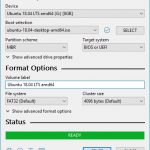Some Lagniappe for You
by Tiny Ruisch
la·gniappe (lnyp, ln-yp)
n. Chiefly Southern Louisiana & Mississippi
1. A small gift presented by a store owner to a customer with the customer’s purchase.
2. An extra or unexpected gift or benefit. Also called regionally boot.
Do you ever need to create USB installation media from bootable ISOs? Do you need to work on a system that doesn’t have an OS installed? Do you need to flash a BIOS or other firmware? There are several utilities you can use for these and other USB purposes. For several years, I’ve been using Rufus.
Rufus is a small utility that helps format and create bootable USB flash drives, such as USB keys, memory sticks, etc. In today’s world of computing, laptops and PCs are often shipped without DVD drives and Blu-ray players. In their absence, Rufus plays a powerful role in helping users to turn their flash drives into a form of reusable DVDs.
It can be especially useful for cases where:
• you need to create USB installation media from bootable ISOs.
• you need to work on a system that doesn’t have an OS installed.
• you need to flash a BIOS or other firmware from DOS.
• you want to run a low-level utility.
Using Rufus is easy. To create a new bootable USB flash drive, simply browse and load your ISO file. Click start, sit back and watch it work. There are a few of customization options. You can change the file system type, edit the volume label, disable quick format or enable disk checking on the USB drive to scan for bad blocks. Advanced options allow you to manipulate cluster size and partition scheme.
Rufus supports both GPT and UEFI boot systems. Depending on the ISO file and how Rufus loads it, there may be additional features and options. For example, selecting a Windows installation ISO, you may be prompted create a Windows installation disk or setup Windows To Go.
Keep in mind that any device you plan to use with Rufus will be formatted and all content will be destroyed. An excellent feature of the program is that only removable drives are listed under available devices. You can’t accidentally format any of your fixed drives.
Rufus does not have to be installed. Just download the file and extract the program. It runs on Windows 7 or later. The program is 1.23KB and runs really fast.
Like most of the software I review for my lagniappe column, Rufus has a price I really like. The cost is zero. Unlike most freeware, there is not even a donate button on the website. The developer explains it like this: “Let me ask you this then: Would you pay $0.99/€0.99 for a utility that simply creates bootable USBs? Or would you just pick one of the many free alternatives? Heck, even I would not pay $0.99/€0.99 for this, despite being acutely aware of the cost associated with its development. So, even if I could try to cash in on the success of Rufus, I see it better to try to benefit millions of users, by providing a free application, instead of just a few thousands with a paid one.”
You can download the program from the Rufus Home Page. I also recommend that you peruse the FAQ page. It is not only informative, but is also interesting.
If you like the program, just tell everyone that you’ve got a SWLAPCUG extra, a bonus perk, a small gift, a present from the club: a little lagniappe.
